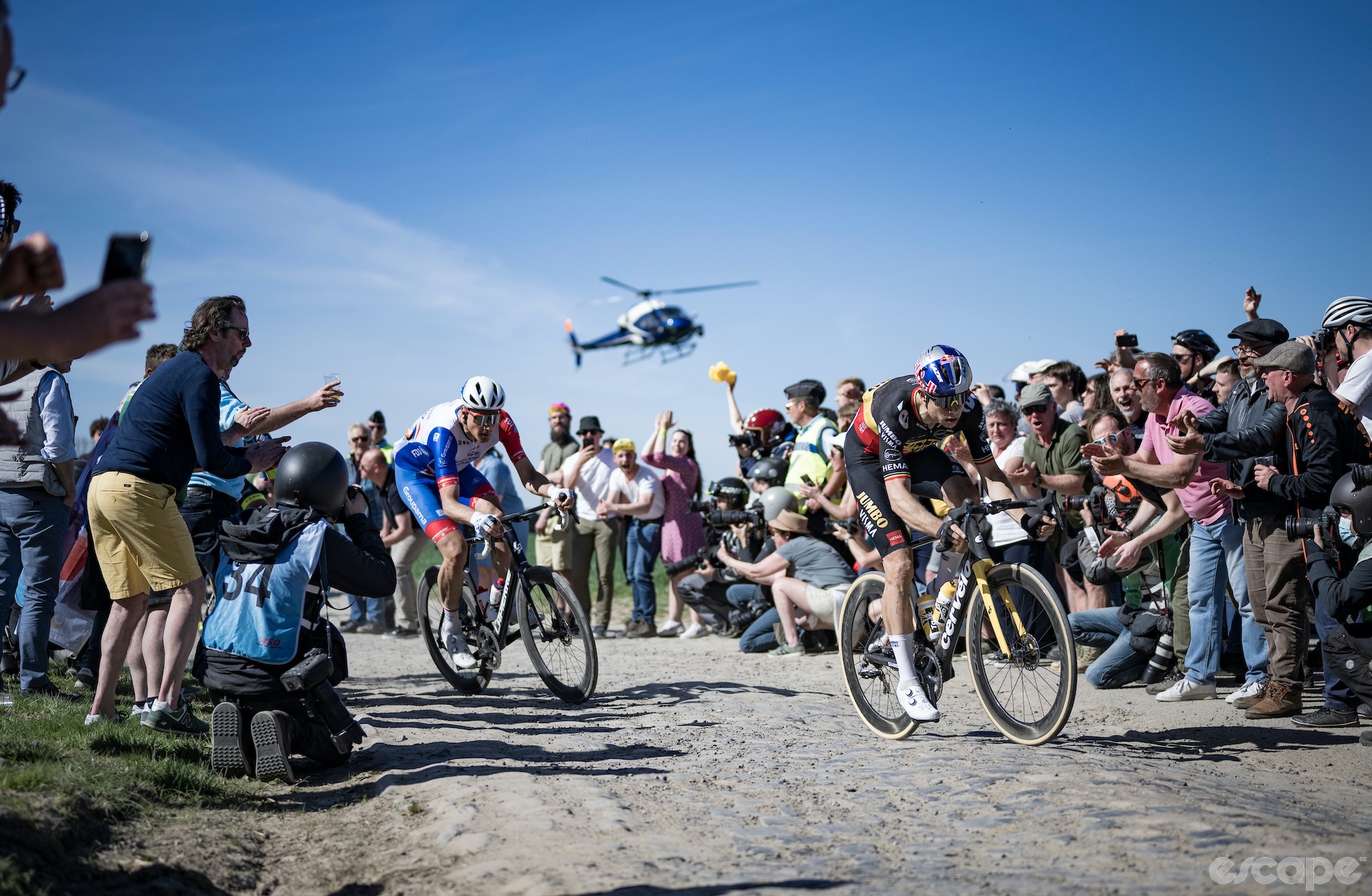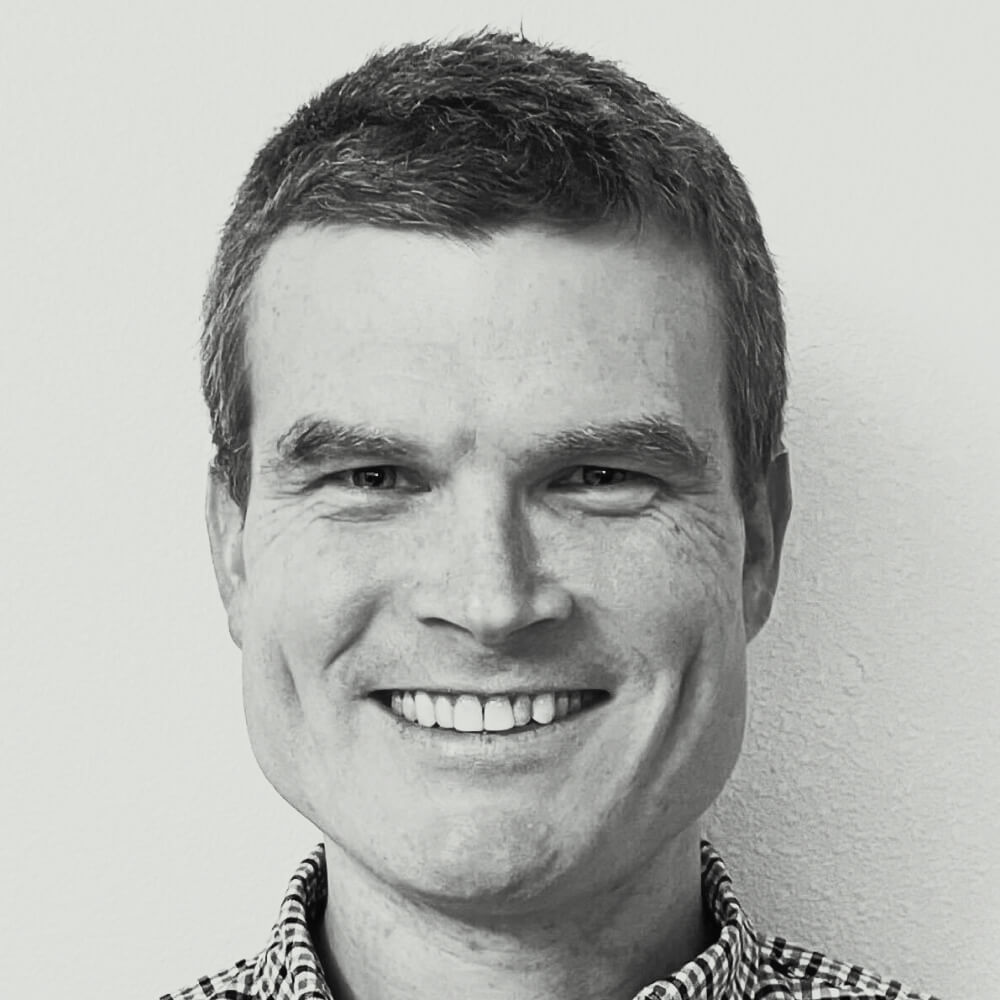With some thrilling races on the Flemish cobblestones in the rearview mirror, the powerhouses of the pavé are heading over the border into France. This weekend will see the professional peloton gleefully ride into Hell, or at least the Hell of the North: Paris-Roubaix.
The women’s race will crown its champion on Saturday and Abby Mickey has your preview for that, and then Mathieu van der Poel (Alpecin-Deceuninck), Wout van Aert (Jumbo-Visma), and the rest of the men’s peloton will roll out on Sunday in a bid to follow up Dylan van Baarle as the newest men’s Paris-Roubaix champ. As ever with this iconic and singular event, now in its 120th year, there will be plenty of storylines and a bevy of stars to follow on the bumpy roads of northern France. Here’s everything you need to know, including some things you didn’t even know you need to know, ahead of the race…
What you need to know
As usual, let’s start with the simple but vital details. Paris-Roubaix will roll out from the neutral start at 11:10 am local time in Compiègne, France (5:10 am ET/10:10 am BST/7:10 pm AEST). A moderate average speed will see the conclusion of the race at approximately 5:23 pm local time (11:23 am ET/4:23 pm BST/1:23 am AEST).
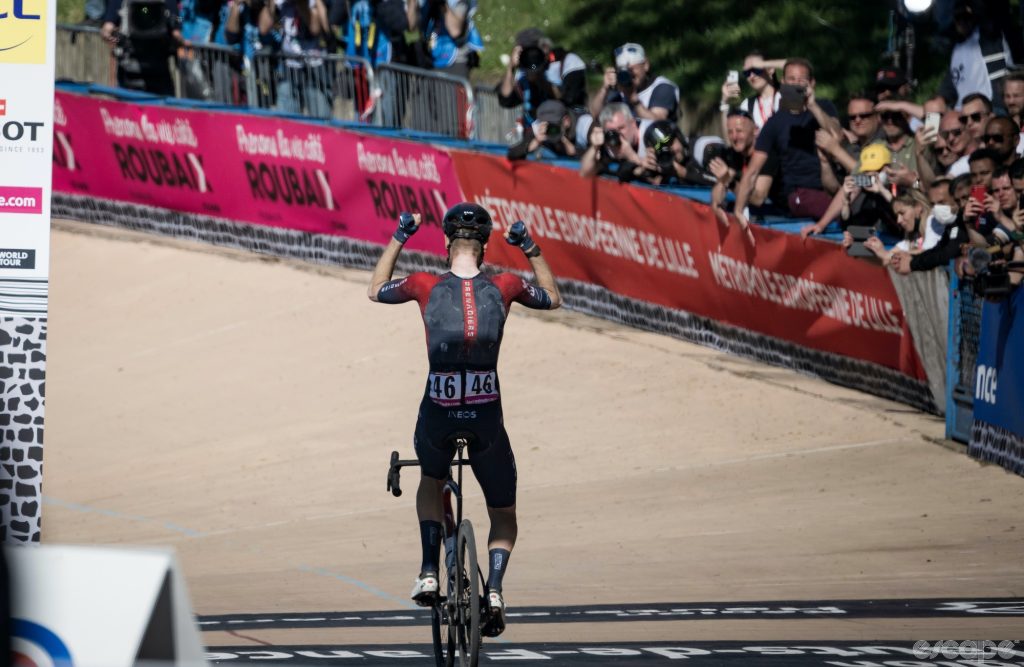
Answering the “when should you tune in?” question is tricky with Roubaix. The decisive attacks often come inside the last half hour but the chaos of the cobbles makes every moment of the race a potentially critical one. You should probably watch the whole thing, and definitely try to catch the final 100 kilometers of the race, with the Trouée d’Arenberg coming at 95 km to go. Expect the riders to get to that point of the race at around 3:00 pm local time (9:00 am ET/2:00 pm BST/11:00 pm AEST).
The route
The Paris-Roubaix peloton will race 256.6 km from the start in Compiègne (which is actually about 100 km north of Paris) to the finish in the Roubaix velodrome. In one sense, the roads covered by the race are almost pancake flat, in that they have barely a hint of elevation gain. On the other hand, those roads aren’t exactly a smooth flat surface. Between Compiègne and Roubaix, 29 sectors of cobblestones await, each of them rated for difficulty on a scale of one to five stars, with five stars being the hardest of the pavé.
This season’s race will likely see action in the same familiar rough patches that have decided this race for years, with the drama poised to start with about 100 km to go. Sector 21 (the organizers count down from 29 instead of counting up from 1) is the four-star stretch from Haveluy to Wallers, which is followed just a few kilometers after its end by the five-star Arenberg Trench. A narrow section of rough road through a dense forest, the Trouée is often where the race really starts to separate. It will at the very least play on the nerves and herald a new stage of the battle as riders jockey for position and try to avoid crashing, even if a decisive attack from this far out is unlikely.
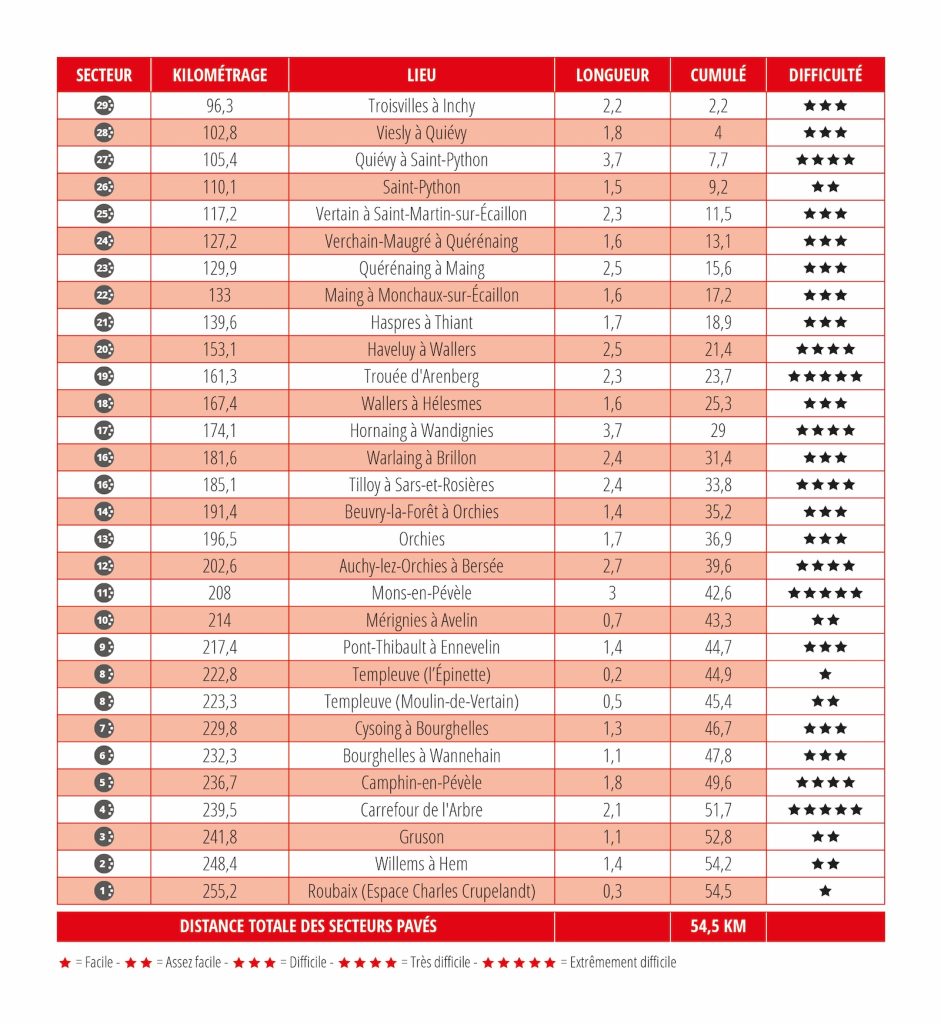
The next five-star sector is the Mons-en-Pévèle, reached with just under 50 km to go. Considering how aggressive we’ve seen even major favorites racing lately, it’s not out of the question that things go down in a big way here. The Mons-en-Pévèle may not feel as caged in as the claustrophobic Arenberg Trench, but at 3 km in length, it’s a long time to be bouncing around as the dust kicks up.
After six more sectors comes the four-star Camphin-en-Pévèle, after which there is little reprieve before the final five-star sector, the Carrefour de l’Arbre. Whoever comes off of the “Crossroads of the Tree” in the lead (with 15 km to go) will be in a great position to battle for the win. The final three sectors are considerably less demanding, and then riders will arrive into Roubaix’s outdoor velodrome where the finish line awaits.
Rain over the next few days could make the ground a bit wet, but as of Thursday evening, the weather for race day looks dry and mostly pleasant, with the forecast for Sunday calling for a high temperature of around 16 °C (61 °F), albeit with a bit of wind likely to factor in certain areas along the course.
The Big Two plus a chosen few
It is a rare thing these days for the Tour of Flanders winner to skip Paris-Roubaix, but that is what Tadej Pogačar (UAE Team Emirates) is doing. Still, that doesn’t mean there will be a shortage of big names in attendance when the race rolls out on Sunday, and some familiar stars stand out as the pre-race favorites – none more so than the pairing you might consider a “Big Two” now that Pogačar is out of the picture. Mathieu van der Poel and Wout van Aert – respectively second and fourth at Flanders – sure look strong right now even if van Aert is still fighting off effects from his crash last Sunday.
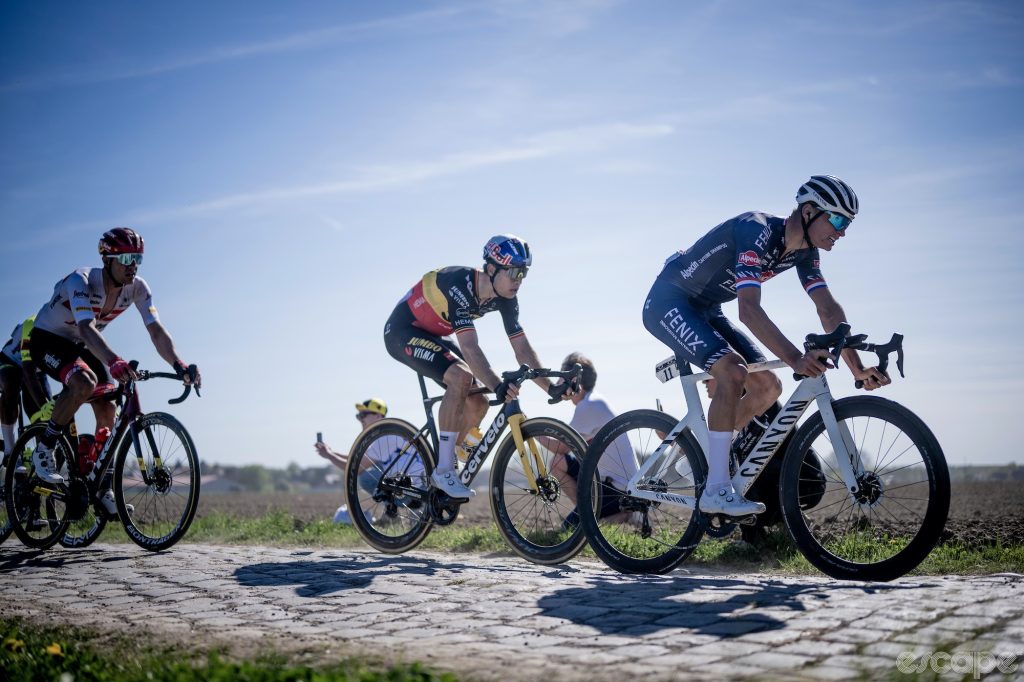
Let’s look at them head to head before we analyze a few other favorites. As of press time, Van Aert is a very slight bookies’ favorite, but it’s close, and for good reason. Trying to determine who has better form is an exercise in subjectivity.
Van Aert outkicked Van der Poel in the E3 finale and was extremely strong at Gent-Wevelgem, but Van der Poel has been better on longer courses, with the win at Milan-San Remo and besting Van Aert at the Tour of Flanders. In other words, judging form is complicated. Historically, Van Aert has the slightest of edges when it comes to Roubaix. He has finished second and seventh in four appearances, whereas Van der Poel has finished third and ninth in only two.
Van der Poel, so far, has had the edge on the very biggest of stages; that San Remo win was his third Monument victory to Van Aert’s one. Van Aert has the edge in the team department though, and Jumbo-Visma has to be happy to have last year’s winner Dylan Van Baarle and a very in-form Christophe Laporte as alternative cards to play, making this a great chance for the team as a whole. Truth be told, however, favored riders and favored teams alike have struggled in recent years at Paris-Roubaix, where contenders lurking just under the surface have a knack for shining brightly.
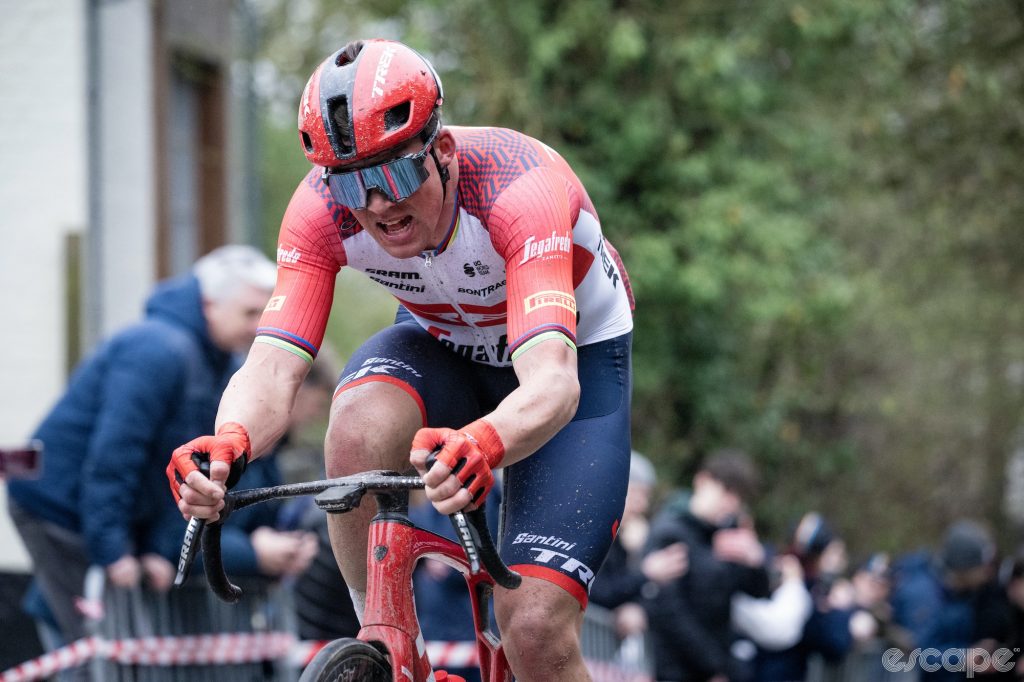
With that in mind, it’s worth looking past the “big two” favorites and their teams too for at least a handful of other big names to watch. Outside of Jumbo-Visma and Alpecin-Deceuninck’s leaders, the next rider who comes to mind as a contender is Trek-Segafredo’s Mads Pedersen, who rode to third at the Tour of Flanders. Like Van Aert and Van der Poel, he has the finishing kick to win from a small group, and a capable team supporting him too. That said, Roubaix has never been kind to him, and he has not finished inside the top 50 across five appearances.
Lastly, let’s mention the big engines of Filippo Ganna of Ineos Grenadiers, who has transformed himself into quite the Classics rider, and Soudal Quick-Step’s Kasper Asgreen, who looked better in Flanders than he has so far this spring. Ganna will lead the charge for Ineos, who will hope to win this race for the second year in a row even though last year’s winner has moved on to a new team, while Asgreen is the likeliest contender for a Soudal squad with one last chance to make a mark this season in a marquee cobbled race.
The Escape Collective star ratings
⭐⭐⭐⭐⭐: Wout van Aert, Mathieu van der Poel
⭐⭐⭐⭐: Mads Pedersen
⭐⭐⭐: Christophe Laporte, Filippo Ganna
⭐⭐: Kasper Asgreen, Dylan van Baarle, Matej Mohorič, Stefan Küng
⭐: Matteo Trentin, Yves Lampaert, Arnaud De Lie, Florian Sénéchal
The conversation
Last week, Abby Mickey told me why Tadej Pogačar was her favorite for Flanders, and things worked out pretty well for that prediction. She’s back again this week to tell me why Paris-Roubaix will be about more than just the “big two.”
Dane Cash: Abby, last week I asked you why we were talking about a big three for Flanders because I thought it was more of a big two, and I’m glad I asked you that because you looked smart when all was said and done and your pick won the race. Fast forward to this week and it really does feel like a big two here, but you still see someone else winning the race. Why?
Abby Mickey: Roubaix is unpredictable and it is very rare that the race favorites end up winning the race. In the case of the big two that you’ve mentioned, they will have targets on their backs and it will take a lot for the two of them to get away without my pick, which is Mads Pedersen.
DC: Readers who were hoping for a real strong back and forth argument here might be disappointed because I kind of agree with you actually. The winners of this race for the past few years have generally not been the top favorites. It’s not like it’s not like people have come out of nowhere to win, but we’ve had sort of people who are a little bit bubbling under the surface if you will. So, why is that Pedersen for you?
AM: I think he proved himself at Flanders to be not only in good shape but also be willing to lose the race, and I think the way that this race is won is more often than not someone who is willing to lose. For me, that would be Pedersen.
DC: That’s a good point. I think Van Aert needs to show us he’s willing to lose a little bit more.
AM: I think that what we saw at Flanders might indicate that Van Aert is potentially not as fit as he would have to be to win Roubaix because if he was going to win, I think he would have to ride away convincingly, and I don’t think that he can do that because of Van der Poel, who will follow anything he does. I think if it is going to be a Jumbo-Visma victory, I’m looking more at Christophe Laporte than Van Aert.
DC: I think Dylan van Baarle is also a big wild card because we have no idea what his form is because he didn’t race Flanders.
AM: The last person to win to double up on wins [at Roubaix] was Boonen in 2008 and 2009, so that would be interesting.
DC: Is there somebody that’s more under the radar that you think has a good chance?
AM: Mikkel Bjerg or Stefan Küng, though he is a little less under the radar, considering he was third last year. That would be like … a mid-radar pick.
DC: Yeah, Küng is actually who I was going to name there as well. He’s been on the podium but there’s not a lot of chatter around him this year and Roubaix just suits him so perfectly. He’s a big guy.
AM: I think Bjerg is riding super well at the moment and would also have literally zero eyes on him.
DC: Yeah, UAE has had a solid team beyond just Pogačar in the Classics and now others will have a chance to shine.
Our picks
Dane Cash: Wout van Aert
Abby Mickey: Mads Pedersen
Jonny Long: Connor Swift (Ed: really Jonny?!)
Kit Nicholson: Wout van Aert
Ronan Mc Laughlin: Alexander Kristoff
Caley Fretz: Filippo Ganna
Matt de Neef: Wout van Aert
What you didn’t know you needed to know
A week after the Tour of Flanders set out from Bruges, Paris-Roubaix treats cycling fans to another historic start town, with a particularly enviable location for a press room: the Château de Compiègne. Long a retreat for the French monarchy (and also the site of Joan of Arc’s capture by the Burgundians in 1430), the town of Compiègne became the site of a new royal palace in the 18th century. Construction begun under Louis XV and was completed under his successor and grandson Louis XVI – who would later be deposed and executed via guillotine in the French Revolution. Napoleon Bonaparte made further renovations in the early 19th century.
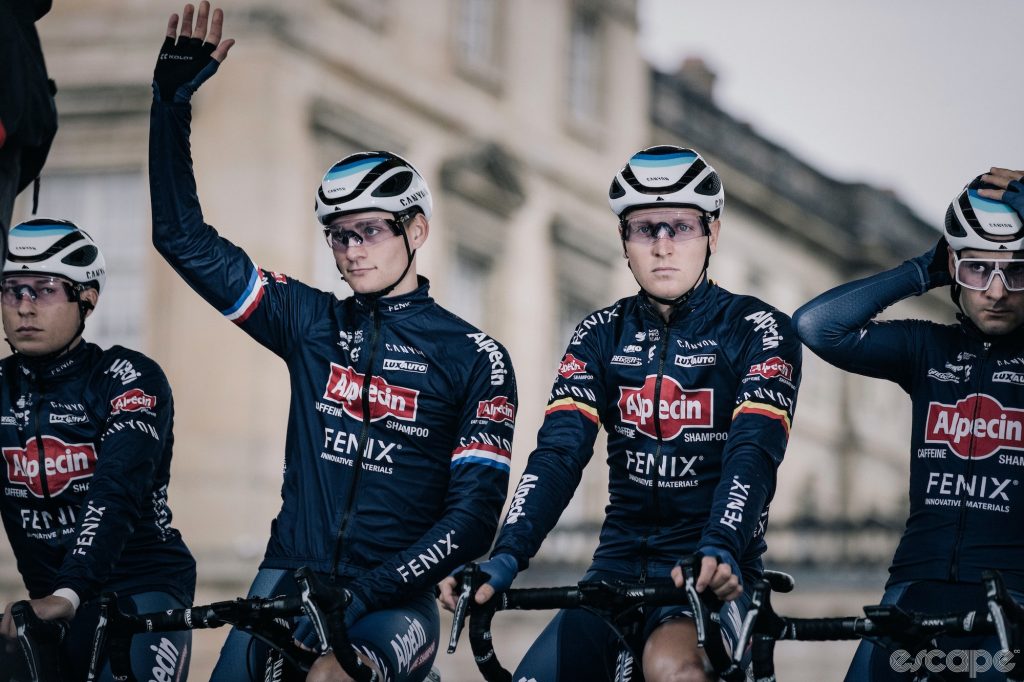
Today, the size and opulence of the Château are still quite a sight in its current state as a museum complex. It has to be said that it’s a fine location to house journalists on deadline – especially compared to the gymnasium press rooms at a few of the other spring races.
After departing from Compiègne, the Paris-Roubaix peloton heads toward a decidedly different locale. On their way north, riders cross over the Somme River and ride through a part of the Western Front where hundreds of thousands of soldiers lost their lives over months of brutal engagements in the First World War. Then, the peloton passes into a part of France where an industrial past still makes its presence felt. Abandoned coal mines run beneath the surface of the landscape with some equipment still visible at ground level near the paved and cobbled roads that take riders into the Lille outskirts and the town of Roubaix.
Roubaix itself grew up as a textile factory town, experiencing explosive major growth in the middle of the 19th century. Like many cities heavily reliant on industry, its population today is significantly lower than it was a century ago, but recent estimates have shown some growth again in the past decade.
If you’re in Roubaix to watch the finale, that means you’re only a few minutes away from the Belgian border; this part of the country is known as French Flanders, after all, and it was part of the medieval County of Flanders. As such, you can certainly find the familiar waffles, frites, and strong ales to accompany your Roubaix viewing experience should you so desire. Flemish stew – beef and onions with beer and mustard – is particularly popular in this region under the French moniker of “Carbonade Flamande.” There’s also Le Welsh, where boiled beer is mixed with cheese and put on toast with egg, apparently inspired by Welsh rarebit.
If those options weren’t heavy enough for you, there’s always andouillette, a sausage of pork, onions, and spices in a casing of intestine, and potjevleesch, or “potted meat,” multiple meats layered together into a heap with natural gelatin and vinegar before being cooled. Enjoy!
What did you think of this story?
